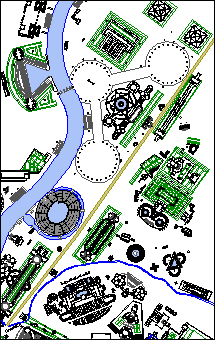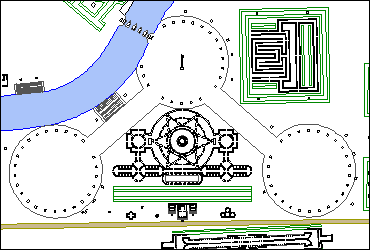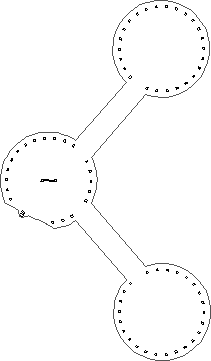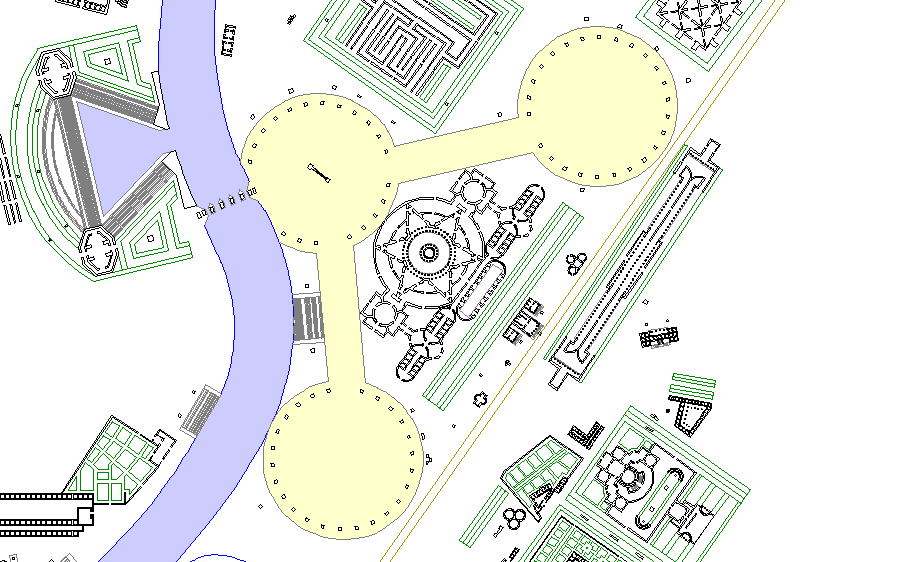Whether the name Gaianum, found in the Regionary Catalogue, was ever applied to the circus of Caligula, is doubtful. It is, on the contrary, very probable that this was the name of an open space just west of the naumachia of Domitian, round which the statues of famous charioteers were erected.
(Platner)
Vincenzo Fasolo, "The Campo Marzio of G. B. Piranesi".
2691e
1956
Mars (Martis)
1998.07.23
Another of the Ichnographia's three major axes is the race course of the Equiria, the annual horse races held in honor of Mars. Piranesi delineates the course as a relatively straight path running the length of the Ichnographia's northern sector, beginning in the south at the Petronia Amnis (which is, however, incorrectly placed within the plan) and ultimately reaching the outskirts of Rome at the plan's edge. With the exception of a few private gardens on a hill overlooking the Equiria, all the structures along the course relate directly to the Equiria or to the military in general. Three long porticos, the Porticus a S.P.Q.R. Amoenitati Dicata, the Porticus Vipsania, and the Porticus Alexandri Severi, line the course, and no doubt are meant to accommodate the spectators of Rome's premier "fest". The buildings and areas related to the military include, the Officinae Balistarium (manufactory of ballista), Officinae Scorpiorum (manufactory of scorpions), the Naumachia Domitiani (a large amphitheater designed for the show of mock naval battles), three Circulus (large circular areas for military drills and exercises, and finally the Officinae Armorum and the Officinae machinarum militarium (manufactories of military arms and machines). Not only do these buildings pay respect to Mars as the god of war, but, as a cohesive group, they essentially constitute Rome's "Department of Defense".
| |

The Equiria (the broad gold line running from the lower left corner to the upper right corner) spans the Ichnographia's northern region, and the course itself runs in an almost true north-south direction.
|
Circulus
Ludus
1998.12.01
circulus : a circular figure; a circle
Ludi : public games, plays, spectacles, shows, exhibitions, which were given in honor of the gods, etc.
ludus : a place of exercise or practice
|
The three large Circulus of the Ichnographia occur between the left bank of the Tiber and the west side of the Equiria, within the northern-most region of the large plan. These circular planes are connected by two Ludus, which are military parade grounds. Essentially, the three Circulus, the two Ludus, and the many Statuae Virorum illustrium (statues of illustrious men) constitute Piranesi's rendition of ancient Rome's formal setting for its military parades and exercises. These broad open areas, along with the activities they facilitate, comply fully with the Equiria's overall character as ancient Rome's military headquarters and as a tribute to Mars. Moreover, placement of the Officinae Armorum and the Officinae machinarum militarium right in the center of the parade fields further reinforces the military specificity of Piranesi's design intention.

Fasolo, a mid-twentieth century art historian, criticized the Circulus and Officinae Armorum complex as "a triangular and star-shaped system to which it is certainly not possible to find a comparison in classical typology." Although Fasolo's observation is correct, it is nonetheless unfortunate that he did not recognize the overriding "Martian honor" theme of Piranesi's Equiria design. Furthermore, Fasolo failed to detect the pattern of inversion Piranesi employs throughout the Ichnographia, particularly with regard to the large plan's archeological and historical inconsistencies, and, in this case, the circular and triangular formation of Piranesi's parade grounds may well represent an inverted delineation of ancient Rome's real military grounds, the huge square shaped Praetorian Camp, which was in an altogether different section of the city.
| |

Circulus with Ludus and Statuae Virorum illustrium
The three Circulus of the Ichnographia are large circular planes, each almost 1000 feet in diameter and decorated with Statuae Virorum illustrium (statues of illustrious men) along their perimeters. The two outer circles are connected to the inner circle by two Ludus (places for public games, etc.).
|
| |
Equiria
1998.12.01
The buildings along the Equiria related to the military are: the Officinae Balistarium, the Officinae Scorpiorium, the Templum Castrum, the Naumachia Domitiani, three Circulus with two Ludus, the Officinae Armorum with its attached Officinae machinarum militarium, the Templa Jovis Martis Veneris, and an Aedicula Isidis, all of which translate into a ballista factory, a scorpion factory, a temple dedicated to Castor (the guide to mariners), a stadium for the show of mock sea-fights, exercise fields, a factory for arms and military machines, and a triple temple dedicated to Jupiter, Mars, and Venus and chapel dedicated to Isis. These buildings, moreover, are interspersed with "statues of illustrious men" as well as the sepulchers of many distinguished military figures from Roman history. This concentration of military functions essentially constitutes a design for ancient Rome's main military headquarters.
Templa Jovis Martis Veneris
1998.12.01
The Templa Jovis, Martis et Veneris is an uncommon temple type in its being three temples connected by a common back wall. This is the only example of such a temple grouping within Piranesi's Ichnographia, and, furthermore, this typology does not occur often (if at all) within ancient Rome's archeological remains. This temple group does not play a significant role within the broad scheme of the Ichnographia, but it does hold a special position with regard to the Circulus and Officinae Armorum complex,of which it is the frontal centerpiece.
Perhaps Piranesi is here saying that all things are equal in terms of love and war.
|



